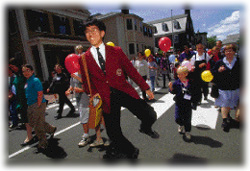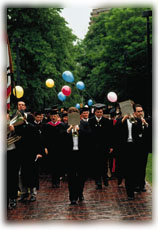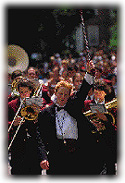Main Menu · Search · Current Issue · Contact · Archives · Centennial · Letters to the Editor · FAQs
 Piping in the Dunster House contingent Photograph by Jim Harrison
Piping in the Dunster House contingent Photograph by Jim Harrison |
"Enter a small but solemn procession," wrote Samuel Eliot Morison in his 1935 volume, The Founding of Harvard College.
He was referring to the academic procession that led off the first Commencement of the new college in Cambridge, generally believed to have been held on September 23, 1642. "Following the Marshal-General of Massachusetts Bay the four halberdiers of Governor's guard precede proud Dunster, marching side by side with grave Winthrop. Next come six members of The Honorable and Reverend The Board of Overseers, the Deputy-Governor..., assistants, and Masters. Possibly some other magistrates and ministers bring up the rear."
On they "marched toward an expectant audience consisting of nine commencers, four junior sophisters, and eight or ten freshmen together with great numbers of gentlemen, ministers and others," sitting on borrowed chairs in the newly finished college hall.
They also marched toward history.
 Processing to the twenty-fifth reunion spread--something to kick up one's heels about. Photograph by Jim Harrison
Processing to the twenty-fifth reunion spread--something to kick up one's heels about. Photograph by Jim Harrison |
When on June 4, 1998, the lines of graduating seniors, president's division, honorands, deans, vice-presidents, dignitaries, and faculties wind along the old diagonal pathways through an "expectant audience" of close to 30,000 people in Tercentenary Theatre, they will take their place in an historic continuum now more than 300 years old. "The anointed eye," wrote David T.W. McCord '21, in Notes on the Harvard Tercentenary, quoting Ralph Waldo Emerson, A.B. 1821, "saw the long, winding train reaching back into eternity."
Earliest of all on commencement morning, in what must--by longstanding tradition--be the first procession of the day, 80 to 100 students from Boston Latin School have processed in two sleepy rows through the Lamont Gate into Tercentenary Theatre to dust or dry the sea of folding chairs and distribute thousands upon thousands of programs.
By 8:30, in the Old Yard, the large president's division is arranging itself behind the president and the University marshal in the area in front of two of the University's oldest buildings, Massachusetts Hall and Harvard Hall. Faculty members form up; "robe after robe scattered a rainbow," David McCord once observed of their academic gowns. At the same time, graduating seniors and alumni of reunioning classes 25 years out and more gather in apparent disarray before beginning their ceremonial walk into the Theatre. Earlier the Harvard and Radcliffe seniors have left their Houses in columns, some summoned by bagpipe, some beckoned by drumbeat, along the streets and through the various gates encircling the Yard to the senior chapel service in Memorial Church, where they gather for the last time alone together as a class.
Behind Sever Hall, brilliantly gowned candidates for advanced degrees and candidates for degrees from the Extension School organize themselves into three divisions for their procession into the Theatre. They have already tinged the sidewalks with color as they approached from their far-flung graduate schools.
 Commotion on the Common: from the Quad to Commencement. Photograph by Jim Harrison
Commotion on the Common: from the Quad to Commencement. Photograph by Jim Harrison |
As the academic train streams along in measured pace, it echoes former Commencement processions. In 1829, Maria Quincy, daughter of President Josiah Quincy, wrote in her journal: "What a scramble! At ten the president in full costume sailed up the aisle, followed by Governor Lincoln and aides, and all the dignitaries, civil and ecclesiastical, of the land...in a tempest of drums and dust...." In 1898, the procession wound round to Sanders Theatre and Charles William Eliot presided from President Edward Holyoke's Jacobean chair. The Harvard Graduates' Magazine noted that "few Commencements have been more impressive than that of 1898," and newspapers of the day severally reported that "the Governor processed from the State House in Boston to the College escorted by his Lancers," and that the 400 seniors marched by twos, "a dignified and impressive body."
"Thus far came our fathers," said Eliot. "Now press you on!"
Press on they do. As the procession passes by University Hall's great west front, the marchers traditionally tip their caps and top hats to the flag of the United States and to the larger-than-life bronze statue of their benefactor, John Harvard.
As they await their turn to enter Tercentenary Theatre, the seniors divide to form two rows through which the president's division parades beneath a panoply of green leaves and waving banners to the platform on the south steps of Memorial Church. When the dignitaries are settled, and the mini-processions from the side aisles have taken their places in the day and in history, the church's large bell, inscribed "In memory of voices that are hushed," is rung by hand in "joyous peal" to mark the beginning of the Commencement Exercises.
 Bringing on the band. Photograph by Jim Harrison
Bringing on the band. Photograph by Jim Harrison |
At their conclusion, the bell again rings joyfully, releasing the platform party to process down the middle aisle of the Theatre, and the pent-up new graduates and their proud entourages to head helter-skelter to luncheons in the Houses, in the graduate schools, and in tents throughout the Yard.
At two o'clock, rain or shine, many reassemble in Tercentenary Theatre for the annual meeting of the Harvard Alumni Association--a less formal event than the morning's exercises: by now, most faculty members and new graduates have doffed their academic regalia. The alumni procession also forms in the Old Yard: marshaled into chronological order by a spirited caller, the classes step out behind the most senior graduates, who proudly carry the placards bearing their class years in white numbers on a field of bright crimson. This unruly yet dignified parade of classes, the young following the old, led by the president and the chief marshal, rolls along in wheelchair or on foot, jubilantly giving its own salute to John Harvard and exchanging news and greetings with the crowd along its path, while on the platform the principal speaker watches in bemusement as the lengthy procession draws near. Along with the speaker, the audience waiting in the Theatre applauds until the last new graduate is seated, and the Alumni Exercises begin.
Commencement 1998 is only a step away, when the newest class joins its predecessors in the academic and alumni parades in what the Reverend Peter J. Gomes described in "Our Secular Sacrament" as a "succession of processions [extending] back in the memory's eye to that first modest Commencement of 1642...." From small roots in that Puritan college has grown the vision, the wisdom, and the joyous pageantry that keeps step with Commencement today.
Main Menu ·
Search · Current Issue · Contact · Archives · Centennial · Letters to the Editor · FAQs
![]()